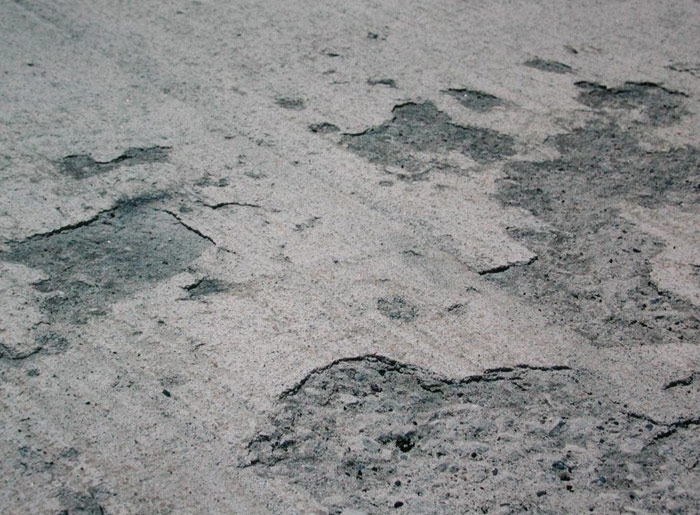Table of Contents
- 0.1 What is Concrete Scaling?
- 0.2 Difference Between Concrete Spalling and Scaling
- 0.3 The importance of Addressing Concrete Scaling
- 1 Causes of Concrete Scaling
- 2 Prevention Measures for Concrete Scaling
- 3 Repairing Concrete Scaling
- 4 Case Studies: Concrete Scaling Examples
- 5 A Few Tips for Maintaining Concrete Surfaces
- 6 FAQs about Concrete Scaling
- 7 To Sum up Concrete Scaling
What is Concrete Scaling?
Concrete scaling refers to the flaking or peeling off of the surface layer of hardened concrete. It is a common issue that occurs due to environmental factors such as repeated cycles of freezing and thawing. Scaling typically starts as localized patches and can extend to larger areas if left unaddressed. Light scaling does not expose the coarse aggregate, while moderate scaling exposes the aggregate and involves the loss of surface mortar. Severe scaling results in the clear exposure of the aggregate and may lead to aggregate popping out.

Difference Between Concrete Spalling and Scaling
While concrete scaling and spalling are often used interchangeably, it is important to understand the distinction between the two. Scaling refers specifically to the flaking or peeling off of the surface layer of concrete due to freeze-thaw cycles. On the other hand, spalling refers to the breaking or chipping of concrete, often occurring in deeper sections of the structure. Spalling is typically caused by factors such as corrosion of reinforcement, excessive stress, or poor concrete mix design.
The importance of Addressing Concrete Scaling
Addressing concrete scaling is crucial to maintain the integrity and durability of concrete structures. Scaling not only compromises the aesthetic appeal of the surface but also leads to reduced strength and increased porosity of the concrete. The loss of surface mortar exposes the underlying coarse aggregate, making it susceptible to further deterioration. If left untreated, scaling can lead to more severe damage such as spalling, which can compromise the structural integrity of the concrete. Search for a good construction company who knows how to lay concrete correctly who can prevent scaling.
Causes of Concrete Scaling
Understanding the causes of concrete scaling is key to implementing effective preventive measures. Several factors can contribute to the occurrence of scaling, including the lack of air entrainment, excessive use of deicing salts, inadequate concrete mix design, improper finishing techniques, insufficient curing and protection, and exposure to corrosive substances.
Lack of Air Entrainment
One of the primary causes of concrete scaling is the lack of proper air entrainment. Air-entrained concrete contains microscopic air bubbles that act as pressure relief mechanisms during freezing and thawing cycles. Without adequate air entrainment, the expansion of water within the concrete can cause internal pressure, resulting in the flaking or peeling off of the surface layer.
Excessive Use of Deicing Salts
The excessive use of deicing salts, such as calcium or sodium chloride, can significantly contribute to concrete scaling. Deicing salts increase the saturation of the concrete and intensify the freezing and thawing cycles, leading to increased damage. Additionally, certain salts, including those found in fertilizers, can chemically attack the concrete surface, exacerbating the scaling process.
Inadequate Concrete Mix Design
The composition of the concrete mix plays a crucial role in preventing scaling. Using a low-strength concrete or a high water-cement ratio can facilitate deeper water penetration and increase the likelihood of scaling. It is important to design the concrete mix with the appropriate water-cement ratio and use well-graded aggregates to ensure the durability and resistance to scaling.
Improper Finishing Techniques
Improper finishing techniques can trap water within the concrete surface, leading to reduced strength and increased vulnerability to scaling. Finishing operations performed while there is still bleed water on the surface can result in a high water-cement ratio in the top layer of the concrete, making it more susceptible to scaling. It is essential to follow proper finishing practices and allow excess bleed water to evaporate before performing finishing operations.
Insufficient Curing and Protection
Inadequate curing and protection of newly placed concrete can contribute to the occurrence of scaling. Insufficient curing reduces the strength and durability of the concrete, making it more susceptible to environmental factors like freezing and thawing. Proper curing methods, such as using liquid membrane curing compounds or covering the surface with wet burlap, help ensure the hydration and strength development of the concrete, reducing the risk of scaling.
Exposure to Corrosive Substances
Exposure to corrosive substances can accelerate concrete scaling. Salts like calcium, magnesium, or sodium chloride, commonly used in deicing chemicals, can chemically attack the concrete surface and increase the likelihood of scaling. It is important to avoid exposing newly placed concrete to such substances and implement preventive measures to protect the concrete from corrosive agents.
Prevention Measures for Concrete Scaling
Implementing preventive measures is essential to minimize the occurrence of concrete scaling. By taking proactive steps during the design, placement, and maintenance of concrete, you can significantly reduce the risk of scaling. Key preventive measures include using air-entrained concrete, proper use of deicing salts, optimal concrete mix design, effective finishing techniques, and ensuring adequate curing and protection.
Importance of Air Entrained Concrete
Air entrainment is crucial to protect concrete from scaling. Air-entrained concrete contains microscopic air bubbles that act as pressure relief mechanisms during freezing and thawing cycles. The presence of these air bubbles reduces internal pressure, preventing the formation of cracks and scaling. It is important to specify air-entrained concrete and ensure that the appropriate air content is achieved during the mixing process.
Proper Use of Deicing Salts
Deicing salts play a significant role in preventing ice formation on concrete surfaces. However, their excessive use can contribute to scaling. It is important to use deicing salts sparingly and avoid the use of aggressive salts such as calcium or sodium chloride in the first year after placing the concrete. Clean sand can be used as an alternative for providing traction during winter conditions. By using deicing salts judiciously, you can minimize the risk of scaling while maintaining the safety of concrete surfaces.
Optimal Concrete Mix Design
The design of the concrete mix is a critical factor in preventing scaling. It is important to use a concrete mix with an appropriate water-cement ratio and well-graded aggregates. A lower water-cement ratio reduces the permeability of the concrete, making it less susceptible to moisture penetration and scaling. Additionally, using high-quality cement and supplementary cementitious materials can enhance the durability and resistance of the concrete.
Implementing Effective Finishing Techniques
Proper finishing techniques are essential to avoid trapping water within the concrete surface and reducing the risk of scaling. Avoid performing finishing operations while there is still bleed water on the surface. Promptly follow initial screeding with bull floating to create a level and smooth surface. It is also important to allow excess bleed water to evaporate before performing finishing operations. By implementing effective finishing techniques, you can ensure that the concrete surface is properly consolidated and minimize the risk of scaling.
Ensuring Adequate Curing and Protection
Adequate curing and protection of newly placed concrete are crucial to prevent scaling. Proper curing methods, such as using liquid membrane curing compounds or covering the surface with wet burlap, help maintain the moisture content and promote proper hydration of the concrete. It is important to follow the recommended curing duration to allow the concrete to develop its strength and durability. Additionally, protecting the concrete from harsh environmental conditions and avoiding exposure to corrosive substances can significantly reduce the risk of scaling.
Repairing Concrete Scaling
When concrete scaling occurs, prompt repair is necessary to prevent further deterioration and maintain the structural integrity of the concrete. The repair process involves assessing the extent of damage, preparing the surface, selecting the appropriate repair method, applying resurfacing materials, and ensuring proper curing of the repaired surfaces.
Assessing the Extent of Damage
Before proceeding with repairs, it is important to assess the extent of the scaling damage. This involves visually inspecting the affected areas and determining the depth of surface loss. Light scaling may require minimal repair, while more severe scaling may necessitate more extensive measures.
Surface Preparation
Proper surface preparation is crucial for the success of concrete scaling repairs. The surface should be thoroughly cleaned, removing any loose debris, dirt, or contaminants. Depending on the severity of the scaling, surface preparation may involve using a hammer and chisel, sandblasting, high-pressure washing, or jackhammering to remove weak or unsound material.
Selecting the Right Repair Method
The choice of repair method depends on the extent of the scaling damage and the desired outcome. For light scaling, surface treatments such as sealers or coatings may be sufficient. Moderate to severe scaling may require resurfacing with a bonded topping or the use of repair mortars. It is important to consult with a professional to determine the most appropriate repair method for your specific situation.
Applying Resurfacing Materials
Once the surface is prepared, resurfacing materials can be applied to restore the damaged concrete. These materials, such as latex-modified concrete or polymer-modified cementitious repair mortars, provide a durable and aesthetically pleasing surface. Proper application techniques, including thorough mixing and correct placement, are crucial to ensure a successful repair.
Proper Curing of Repaired Surfaces
After the repairs are completed, it is important to properly cure the repaired surfaces. Curing helps the resurfacing materials develop their strength and durability. Follow the recommended curing methods, such as using curing compounds or covering the surface with wet burlap, to promote proper hydration and ensure the longevity of the repairs.
Case Studies: Concrete Scaling Examples
To provide a better understanding of concrete scaling, let’s explore some case studies that showcase different degrees of scaling and the corresponding damage.
Light Scaling: Small Patches with No Aggregate Exposure
In light scaling cases, the surface of the concrete exhibits small patches of flaking or peeling, but the underlying aggregate remains intact. This type of scaling does not pose an immediate threat to the structural integrity of the concrete. However, if left unaddressed, it can progress to more severe scaling and potentially compromise the long-term durability of the surface.
Moderate Scaling: Exposed Aggregate and Loss of Surface Mortar
Moderate scaling involves the exposure of the underlying aggregate and the loss of surface mortar. The concrete surface may exhibit patches where the aggregate is clearly visible. This level of scaling indicates a more significant deterioration of the surface and requires proper repair and maintenance to prevent further damage.
Severe Scaling: Aggregate Popping Out and Significant Surface Loss
Severe scaling is characterized by the popping out of aggregate particles and a significant loss of surface mortar. The concrete surface may have large areas of exposed aggregate and noticeable surface degradation. This level of scaling requires immediate repair to prevent further deterioration and potential safety hazards.
Very Severe Scaling: Loss of Surface Mortar and Coarse Aggregate
Very severe scaling represents the most advanced stage of concrete deterioration. In this case, the surface mortar and coarse aggregate particles are significantly compromised, and large sections of the concrete surface may be affected. Repairing very severe scaling often involves more extensive measures, such as complete removal and replacement of the damaged concrete.
A Few Tips for Maintaining Concrete Surfaces
To ensure the long-term durability and performance of concrete surfaces, regular maintenance and proactive measures are essential. Here are some tips to help you maintain your concrete surfaces and minimize the risk of scaling:
- Regularly inspect the concrete surfaces for any signs of damage or deterioration.
- Avoid using harsh chemicals or deicing salts that can contribute to scaling and corrosion.
- Promptly address any surface damage by implementing appropriate repair methods.
- Clean the concrete surfaces regularly to remove dirt, debris, and contaminants.
- Apply a protective sealer or coating to enhance the resistance of the concrete surface to scaling and other forms of deterioration.
- Avoid heavy traffic or excessive loads on the concrete surface, as it can lead to premature wear and tear.
- Ensure proper drainage to prevent water accumulation and minimize the exposure of the concrete to moisture.
By following these maintenance tips, you can extend the lifespan of your concrete surfaces and minimize the need for extensive repairs.
FAQs about Concrete Scaling
What is the Difference Between Concrete Scaling and Spalling?
While concrete scaling and spalling are often used interchangeably, they represent distinct forms of concrete deterioration. Scaling refers specifically to the flaking or peeling off of the surface layer of concrete due to freeze-thaw cycles. Spalling, on the other hand, involves the breaking or chipping of concrete, often occurring in deeper sections of the structure. Spalling is typically caused by factors such as corrosion of reinforcement, excessive stress, or poor concrete mix design.
Can Concrete Scaling be Prevented Completely?
While it is not possible to completely eliminate the risk of concrete scaling, implementing proper preventive measures can significantly reduce its occurrence. By using air-entrained concrete, avoiding excessive use of deicing salts, following optimal concrete mix design, implementing effective finishing techniques, and ensuring adequate curing and protection, you can minimize the risk of scaling. Regular maintenance and prompt repair of any surface damage are also crucial in preventing the progression of scaling.
How Long Does Concrete Repair Last?
The longevity of concrete repairs depends on various factors, including the extent of the initial damage, the quality of the repair materials and techniques, and the level of maintenance and care provided. Properly executed and maintained concrete repairs can last for many years, providing durable and aesthetically pleasing surfaces. However, it is important to note that regular inspections and proactive maintenance are essential to address any signs of deterioration promptly and prevent further damage.
To Sum up Concrete Scaling
Concrete scaling is a common issue that can significantly impact the durability and aesthetic appeal of concrete surfaces. By understanding the causes of scaling and implementing effective preventive measures, such as using air-entrained concrete, proper use of deicing salts, optimal concrete mix design, and effective finishing techniques, you can minimize the risk of scaling. In the event that scaling does occur, prompt repair and proper maintenance are crucial to prevent further deterioration and maintain the structural integrity of the concrete. By following these guidelines and investing in the proper care of your concrete surfaces, you can ensure their longevity and enhance their performance for years to come.
Remember, timely action and regular maintenance are key to protecting your concrete surfaces from scaling and ensuring their long-term durability and performance.


